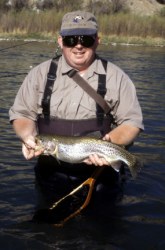Thinking Outside the
(Fly) Box
by Karen
Christopherson |
Click
Here to read
more "Fish Tails" |
(Ed. note - this article first appeared on
eangler.com, April 2001)
You all know the
drill. You're flyfishing one of those famous rivers full of large trout,
which happen to be very smart. The way some people talk, these trout
graduated from Harvard with a PhD in fly identification. So, like
everyone else, you put on your fluorocarbon tippet and masterfully-tied
size 22 midge nymph. But today, nothing is happening — no hits, no
strikes, you're out of luck.
Now is the time to
try something completely different.
Try a big fly, or
something really bright — yes, something you've never used on this
river before.

Last summer, I had
some revelations about this. First, I had browns on one stretch of river
strike my fluorescent pink strike indicator twice. I don't mean they
nuzzled it; they latched on to it, they had their teeth around it. So I
started tying some bright pink flies.
Next, we had two
separate visits from Canadian friends, both flyfishermen. They brought
along their heavy rods and big flies. Not wanting to insult them, I
didn't say anything about their style. Out on the river, I would be
using a size 18 dry, an Adams or other favorite. Both of these Canadians
would tie on a size 2 or 4 streamer or wet fly. And guess what? They
caught almost as many trout as I did!
 |
Thinking outside the box can help you catch
large fish on slow days (Photo courtesy Al Marlowe) |
The
trend in recent years seems to be towards fly imitations of nymphs or
dries of winged insects, with the occasional terrestrial thrown in. What
happened to the large streamers of yesteryear? Do we forget that trout
enjoy eating smaller fish, minnows, fry and the like? I know you have a
woolly bugger in your fly box, but let's get a little more creative than
that. Most trout don't see that many large flies. When they do, they
should view your large fly as a meal that's easier than going after
hundreds of midges or nymphs.
Resources/Other Info:
|